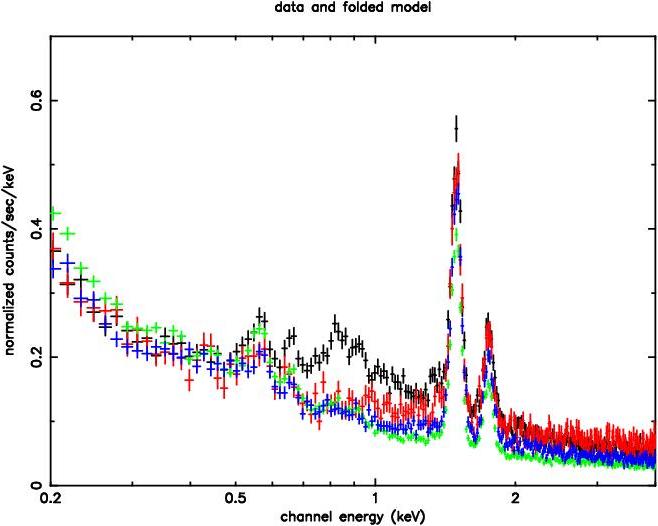EPIC 'Blank Sky' Pre-Oct 2008 - XMM-Newton
XMM-Newton EPIC 'Blank Sky' Background
This page describes the general Blank Sky event files and associated exposure maps that were created prior to October 2008. This page has been superseded by the page found here. A user may now wish to request a tailor-made Blank Sky event file by submitting a request using the form found here.
General XMM-Newton background 'blank sky' events files for the 3 EPIC instruments in their different instrument mode/filter combinations have been constructed using a superposition of many pointed observations of pipeline product data from the 2XMM reprocessing (Second XMM-Newton Serendipitous Source Catalogue) and have been processed with SAS 6.5. Exposure maps in the different instrument/mode/filter combinations have also been produced. Refer to the related paper by Carter and Read (A&A 464, p1155, 2007) for further information. On these web pages, details can be found on how to obtain these background products together with related software.
Contents:
- Latest updates to these web pages
- XMM-Newton blank sky event files
- Available XMM-Newton background files
- Software available relating to background files
- Using these background event files (some brief guidance)
- Properties of the background files
Latest Updates
- Nov-2008: Restructuring of this page. This page refers to Blank Sky files prior to October 2008.
- Sep-2008: Advice added to website regarding scaling of exposure maps and the use of refilled event files
- Nov-2007: New script BGSelector added to replace SelectRADec, with much more functionality
- May-2007: Additional exposure maps provided, created using flag (FLAG & Ox2fb0008)==0
- May-2007: Corrections to unfilled vignetted exposure maps
- May-2007: Removal of some component observations from blank sky files, adjustments to BlankSky.tgz
- May-2007: TCRVL6 and TCRVL7 keywords added to event files
- Feb-2007: TLMINn and TLMAXn keywords added to event headers
- Dec-2006: Advice regarding use of files with SAS tasks and the addition of keywords
- Aug-2006: GTI extensions revised for all event files. Modified BlankSky.tgz
- Jun-2006: TSTART and TSTOP keywords added to EXPOSURE extensions of unfilled event files
- May-2006: Initial web site
XMM-Newton blank sky event files
This page was produced as a result of work within the XMM-Newton EPIC Background Working Group. It follows on from work completed by A. Read, whilst at the University of Birmingham, the results of which can be found within the associated previous background web pages. The current work presented on these pages includes the analysis of many more pointed observations and the addition of new tools in comparison with the work previously presented.
When performing detailed XMM-Newton EPIC analysis, a good knowledge of the background is required. Sometimes it may be possible to extract the background from a region close to the particular source one is interested in (using a so-called 'local' background). For a large or extended source however, one may have to extract the background far from the target source (the source may in fact be so extended, that no local background is visible within the field of view). Here, a number of effects can cause the extracted local (off-axis) background to be highly inappropriate in analysing the (normally on-axis located) target source, such as the effective area of the mirrors with off-axis angle, instrumental fluorescence and the spectral response which can depend on the position on the detector. These off-axis effects are corrected in the XMM-Newton EPIC calibration.
The files available via these pages are intended to be used in case of difficulty extracting a suitable background region from a user's observation. A guide to these files and their use can be found below.
Available XMM-Newton background files
The pre-October 2008 background event files and relevant exposure maps can be obtained here.
There are background event files for MOS1 and MOS2 in full-frame mode and PN in both full-frame and extended full frame mode. Each filter mode combination event file is available. Filters can be thin, medium or thick. Therefore there are twelve different instrument-filter-mode combinations. For each event file there are two types of exposure map: vignetted and non-vignetted. Note that the vignetted maps apply to the energy range 0.2-10 keV.
The creation of these files and background flare screening
The blank sky files were created from sets of files available from the 2XMM reanalysis. Each individual component file that becomes part of a specific instrument-filter-mode set has undergone source removal and flare-screening. The flare screening is based on the 2XMM PPS background time series files. For MOS they are created for full-field events above 14 keV, and with the selection expression (PATTERN==0) && #XMMEA_22 && ((FLAG & 0x762ba000) == 0), whereas for PN, they are created for full-field, bright-source-excluded all-pattern events between 7 keV and 15 keV. The flare removal that has been used here in the creation of the blank sky files (thresholds: 2 counts/s for MOS and 60 counts/s for PN) was based on the very conservative limits suggested by the EPIC instrument teams. A user may therefore wish to undertake some additional flare screening steps when using these files.
Refilled and unfilled event files
There are two types of background event files: unfilled and refilled. The unfilled event files result from the stacking of pipeline product event files that have been subjected to various filtering steps, which includes the removal of sources. Therefore proper consideration of the exposure maps is required when using the final event file that applies to a set of combined observations. However, we have developed a method to fill in the source regions that are extracted from each individual observation by sampling events close to the extracted regions and filling the vacated region of the event file, randomising just the spatial coordinates. Adjustments are made for region crossovers and chips edges. This results in smooth event file images and exposure maps. Both types of event file are available here, with corresponding vignetted and non-vignetted exposure maps. The naming convention described below indicates which type of event file is available for download.
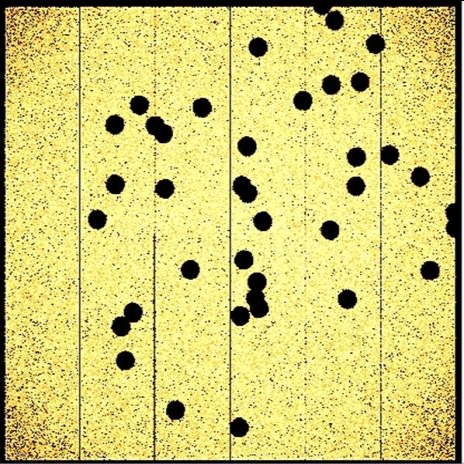 |
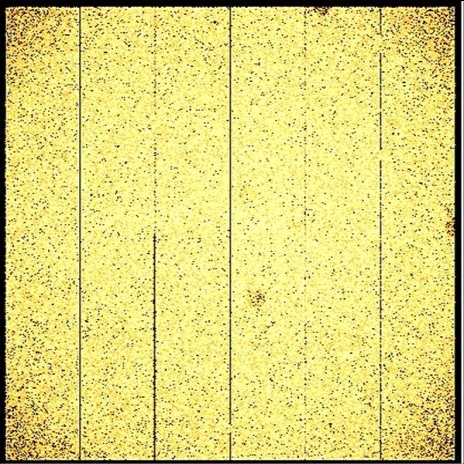 |
| On the left is shown an image created from a pn events file with sources removed, and on the right, the image of the events file after the event filling procedure | |
Location on the sky dependence
In some cases, due to very large file sizes of the final stacked event files, it was necessary to consider individual observations for stacking based on their location on the sky. These files were split into 'near-hemispheres', based on the galatic centre and galactic anti-centre. This is shown in the file naming convention shown below by the "location" tag.
Details of the observation sets
The processing of the observations that contribute to the final files involved the manipulation of data from approximately 200 observations. The table below details the total exposure time that each final instrument-filter-mode combination event file incorporates, after all cleaning has been completed. Users will need to scale the event files accordingly when applying these sets to their observations.
| File | Final total time (s) | Number of files used |
|---|---|---|
| MOS1 thin full frame | 2141130 | 111 |
| MOS1 medium full frame | 1526510 | 60 |
| MOS1 thick full frame | 250323 | 11 |
| MOS2 thin full frame | 2034300 | 109 |
| MOS2 medium full frame | 1618360 | 62 |
| MOS2 thick full frame | 287884 | 12 |
| PN thin full frame | 960633 | 41 |
| PN medium full frame | 1066180 | 32 |
| PN thick full frame | 184756 | 9 |
| PN thin extended full frame | 825204 | 62 |
| PN medium extended full frame | 435142 | 27 |
| PN thick extended full frame | 58664 | 3 |
The naming scheme is detailed below.
Available Files
Event files
The pre-October 2008 files are found here.
Event files take the following file-naming convention:
"instrument"."filter"."mode".EVLI"type""location".FIT
The following table explains the meaning of the symbols for instrument, filter, mode and type.
| Symbol | Use | Meaning |
|---|---|---|
| PN | instrument | pn |
| M1 | instrument | MOS1 |
| M2 | instrument | MOS2 |
| T | filter | thin |
| M | filter | medium |
| K | filter | thick |
| FF | mode | full frame |
| EF | mode | extended full frame |
| U | type | unfilled |
| R | type | refilled |
| A | location | galactic anti-centre |
| C | location | galatic centre |
| P | location | not position specific |
Example: M1.T.FF.EVLIUP.FIT
This file would be the unfilled events file for MOS1, thin filter with full frame mode, and includes events that can come from any location on the sky.
Exposure Maps
Individual exposure maps that apply to the event files are available. They take the following file-naming convention:
"instrument"."filter"."mode".EXM"vig""type""location".FIT
where:
- "instrument", "mode", "filter", "type" and "location" are the same as described in the Events file section above.
- "vig" indicates whether the exposure maps accounts for vignetting (V if a vignetted exposure map, N if not).
Example: PN.K.EF.EXMNRP.FIT
This file would be the non-vignetted refilled exposure map for PN, thick filter with extended full frame mode and applies to the event files where events can come from any location on the sky.
There are additional exposure maps available that were created with the additional expression (FLAG & Ox2fb0008)==0. These files can be found in AF_FILES sub-directory of the file download area page, and have the suffix 'af' added to the filename.
Software available relating to background files
All related software can be obtained from here.
Scripts
Scripts also applicable to the Blank Sky files as prior to October 2008 as well as the new style files can be found here. An additional script is available for use with the file as prior to October 2008 and is detailed below.
BGSelector
This script replaces and supersedes the script SelectRADec. This script can be used to select events from a Blank Sky event file, using a set of selection criteria as given by the user. The user can select on events within a given radius from a set of coordinates, either equatorial (J2000) or galactic, by revolution number, exposure time, XMM-Newton time or nH column density values. A final event file and exposure map is produced along with a text file summarising the results of the selection. This script requires the download of a compressed tar file, BlankSky.tgz which contains a set of individual exposure map files (in the sub directory Exposures), the script BGexpmerge, the python coordinate conversion routine (galcoordstoradec.py) and the master list of observations (Mastertable.txt). Please note that the Mastertable.txt file was updated in November 2007. This file should be downloaded, unzipped and untarred accordingly.
Using these background event files
Previous guidance
A brief introduction to using these files is given at the Birmingham site.
Properties of the (pre-October 2008) Background Files
Variations in spectra with count rate
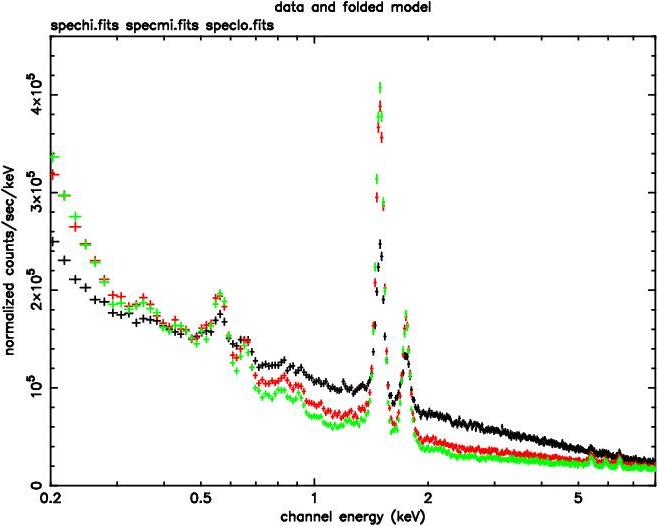 |
|
| Variation of spectra with count rate. Black = high, red = medium and green = low count rate | |
The user should be aware that spectra produced from the files presented here show slight variations with count rate, where count rate is classified as being high, medium or low. In the future a tool may be supplied on these pages to select count rates that are specifically appropriate for a user's data.
Variations in spectra over the sky
Regions of the sky have been selected around four coordinate centres: the galactic centre, galactic anti-centre, the south galactic pole and the north galactic pole. These regions were selected using the script BGSelector as described above. Spectra were produced for each of the resulting subset event files. These are shown plotted here. Note that the galactic centre shows a higher count rate at between approximately 0.3 keV to 3 keV due to increased soft x-ray emission in the galactic plane and centre.
Blank Sky count rates
For each of the blank sky files (based on the instrument-filter-mode classification) count rates have been calculated in the standard SSC energy bands (0.2-0.5 keV, 0.5-1 keV, 1-2 keV, 2-4.5 keV, 4.5-12 keV) both for in and out of field of view (FOV) areas for both events with pattern 0, and events with patterns equal to or less than 12 for MOS and events with patterns equal to or less than 4 for PN. These count rate plots, giving an estimate of the to be expected EPIC background in 'low background' periods, are available here.
Internal BG
By looking at one of the refilled event files for the PN between the energies of 7.8 keV and 8.2 keV, one can see the instrumental copper 'hole' which has only slightly been affected by the ghosting procedure as described above (refilled and unfilled event files). This effect, therefore, is only of minimal significance.
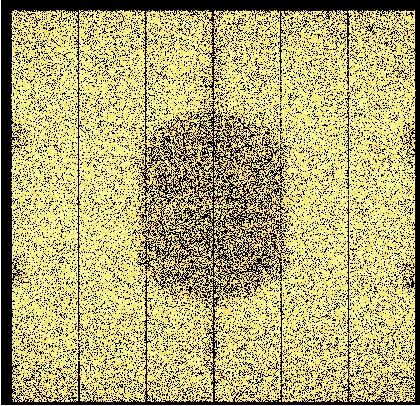 |
|
| Image made from a PN event file showing the Cu line between 7.8 keV and 8.2 keV | |
- Removed a total of (1) style text-align:center;
- Removed a total of (6) align=center.
- Removed a total of (24) align=right.
- Removed a total of (7) border attribute.








































 Sign in
Sign in
 Science & Technology
Science & Technology
